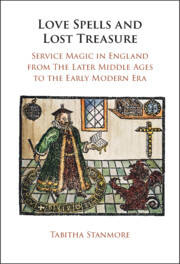 Love Spells and Lost Treasure
Love Spells and Lost Treasure Conclusion
Published online by Cambridge University Press: 06 January 2023
Summary
Magic is a constant across the world and throughout time. The place it inhabits in society and how those who practise it are treated are the variables; its presence is never a novelty. While witchcraft is recognised as a phenomenon of the medieval and early modern periods, service magic – performed to a useful end in exchange for a fee, and more common than witchcraft – has been overlooked. This book gathers over 700 instances of magic use in England between the fourteenth and seventeenth centuries to demonstrate the entrenched nature of service magic in premodern society, and explore how it was perceived and incorporated into daily life. Service magic was well established by the time of the witch trials, and was recognised as a useful tool from at least the fourteenth century. It was used to meet needs that nothing else could address, like healing the chronically sick, finding lost goods, ending poverty by locating buried treasure, and kindling love. Though its use was technically illicit, first treated as a moral crime and then a secular one from the mid-sixteenth century, for most people magic was an accepted and even welcome aspect of everyday life.
Keywords
- Type
- Chapter
- Information
- Love Spells and Lost TreasureService Magic in England from the Later Middle Ages to the Early Modern Era, pp. 246 - 250Publisher: Cambridge University PressPrint publication year: 2022
